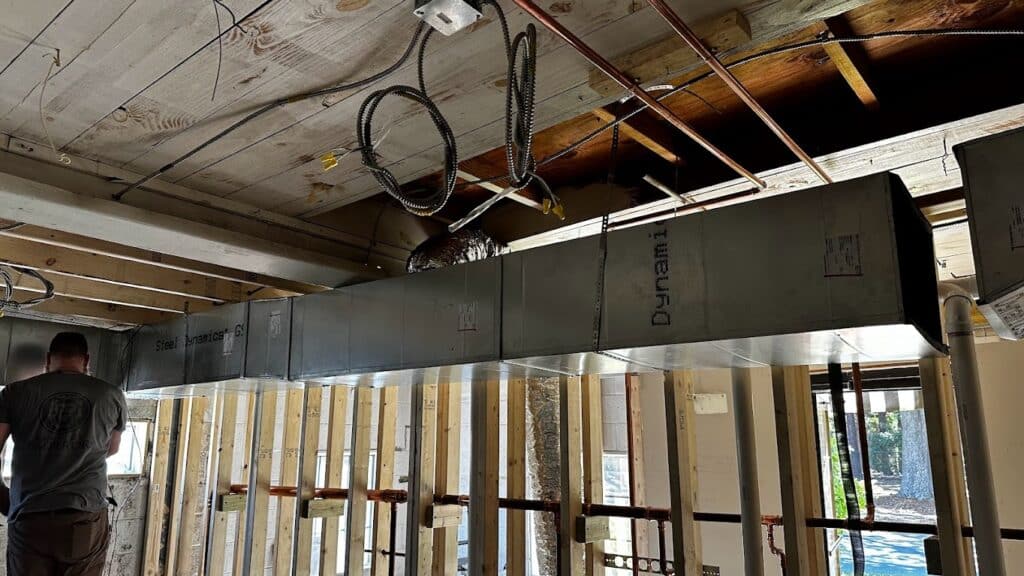7-Step Guide to Having the Ultimate HVAC Ductwork
Introduction to HVAC Ductwork
HVAC ductwork is the essential network of tubes and channels that distributes heated or cooled air throughout your home or commercial building. A well-designed and properly installed ductwork system ensures that your heating, ventilation, and air conditioning (HVAC) system operates at peak performance, providing consistent temperatures, improved indoor air quality, and energy efficiency.

Common Types of Ductwork Material
Various materials are used in HVAC ductwork construction, each with advantages and disadvantages. Let’s take a look at the most common types:
Galvanized Steel Ducts
Galvanized steel ducts are the industry standard, offering durability and resistance to rust and corrosion. These ducts come in rectangular, round, or oval shapes and can be insulated or uninsulated.
Flexible Ducts
Flexible ducts are made from lightweight, flexible materials such as plastic, polyester, or aluminum. These ducts are easy to install and can be used in tight spaces, making them popular for retrofit projects. However, they may be prone to sagging, which can reduce airflow and efficiency.
Fiberglass Ducts
Fiberglass ducts are constructed with a layer of fiberglass insulation between an inner and outer shell. This design provides built-in insulation, reducing heat loss or gain through the duct walls. Fiberglass ducts are lightweight but may be more susceptible to damage.

Click Here to Download Service Emperor’s Field HVAC Duct Sizing Chart
Ductwork Design and Layout Principles
Designing an efficient ductwork system is critical to the overall performance of your HVAC system. Here are some key principles to consider:
Proper Sizing
Duct sizing ensures adequate airflow and maintains balanced temperatures throughout your home. Ducts should be sized according to your specific space’s heating and cooling load calculations.
Efficient Layout
The layout of your ductwork system should minimize the length of duct runs and limit the number of bends and turns, which can create resistance and reduce airflow. A well-planned layout also allows for easy access to ducts for maintenance and cleaning.
Balanced Airflow
To maintain consistent temperatures, your ductwork system should be designed with an even distribution of supply and return air. This balance ensures that conditioned air is effectively delivered to all areas of your home, promoting comfort and energy efficiency.
Proper Ductwork Sealing Techniques
Sealing your ductwork is crucial to prevent air leaks and improve the overall efficiency of your HVAC system. Here are some standard duct-sealing methods:
Mastic Sealant
Mastic is a durable, flexible sealant that can be applied to joints and seams in the ductwork. It creates an airtight seal, preventing air leaks and improving efficiency.
Foil-backed Tape
Foil-backed tape is designed specifically for HVAC ducts and can be used to seal seams and connections. This tape has a strong adhesive that can withstand temperature fluctuations, making it a reliable option for duct sealing.
Aerosol Sealant
Aerosol sealant is a spray-on product that can be used to seal hard-to-reach areas or small gaps in ductwork. This method can be more expensive and less effective than other sealing techniques but may be suitable for specific applications.
Ductwork Insulation and Energy Efficiency
Insulating your ductwork is essential to prevent heat loss or gain through the duct walls, improving energy efficiency and reducing utility costs. Here are some popular insulation options:
Fiberglass Flexible Insulation
Fiberglass insulation is available in blankets or rolls and can be wrapped around your ducts to provide a thermal barrier. This material is cost-effective and easy to install but should be handled with care to avoid skin irritation.
Rigid Foam Insulation
Rigid foam insulation is a lightweight and durable option that can be cut to fit around your ducts. It provides excellent thermal resistance and is less prone to damage than other insulation types.
Reflective Insulation
Reflective insulation consists of a foil-faced material that reflects heat away from your ducts. This insulation is easy to install and can be used in combination with other insulation materials for enhanced performance.
Ductwork Cleaning and Maintenance
Regular cleaning and maintenance of your HVAC ductwork system are essential to ensure optimal performance and indoor air quality. Here are some tips for keeping your ducts clean and well-maintained:
- Inspect and clean ducts regularly: Check for dust buildup, mold, or damage and clean or repair as necessary.
- Change air filters regularly: Replace your HVAC system’s air filters every 1-3 months to prevent dust and debris from entering your ducts.
- Seal leaks and gaps: Inspect your ductwork for air leaks and seal them using the appropriate method to maintain efficiency.
- Schedule professional duct cleaning: Hire a professional HVAC contractor to clean your ducts every 3-5 years, or more frequently if needed.
Hiring Professional HVAC Contractors
To ensure the best results for your HVAC ductwork system, hiring a qualified and experienced HVAC contractor is important. Here are some factors to consider when selecting a contractor:
- Experience: Look for a contractor with a proven track record of successful ductwork installations and repairs.
- Certifications: Choose a contractor with appropriate certifications, such as NATE (North American Technician Excellence) or ACCA (Air Conditioning Contractors of America).
- Insurance and Licensing: Verify that the contractor is licensed and insured to perform HVAC work in your area.
- References and Reviews: Ask for references and read online reviews to learn about the contractor’s reputation and customer satisfaction.
Following these guidelines ensures your HVAC ductwork system is designed, installed, and maintained for optimal performance, comfort, and energy efficiency.
Book a service call to replace or seal your existing ductwork.
